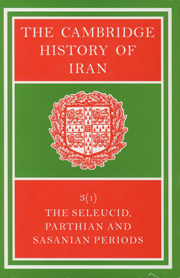Book contents
- Frontmatter
- Introduction
- PART 1 POLITICAL HISTORY
- PART 2 NUMISMATICS
- 8(a) PARTHIAN COINS
- (b) MINOR STATES IN SOUTHERN IRAN
- 9 SASANIAN COINS
- PART 3 IRANIAN HISTORICAL TRADITION
- PART 4 IRAN AND HER NEIGHBOURS
- Bibliography
- Plate section
- Plate section
- Plate section
- Map 3. The western regions of the Sasanian empire">
- Map 11. The Silk Road from China to the Roman Orient
- References
9 - SASANIAN COINS
from PART 2 - NUMISMATICS
Published online by Cambridge University Press: 28 March 2008
- Frontmatter
- Introduction
- PART 1 POLITICAL HISTORY
- PART 2 NUMISMATICS
- 8(a) PARTHIAN COINS
- (b) MINOR STATES IN SOUTHERN IRAN
- 9 SASANIAN COINS
- PART 3 IRANIAN HISTORICAL TRADITION
- PART 4 IRAN AND HER NEIGHBOURS
- Bibliography
- Plate section
- Plate section
- Plate section
- Map 3. The western regions of the Sasanian empire">
- Map 11. The Silk Road from China to the Roman Orient
- References
Summary
INTRODUCTION
The Achaemenian, Arsacid and Sasanian dynasties which together ruled Iran for more than a millennium, all struck coins, but the issues of the last of these have come to be of the greatest importance; indeed, this coinage is an invaluable source of information about the history, culture and economic life of the Sasanian state. Virtually all that we know about Sasanian numismatics is based on the coins themselves; they evidently neither continue precisely the Arsacid tradition, nor break with it completely.
The Sasanians adopted the denominations and weight standard used by their predecessors, and like the Arsacids they kept the obverse for the ruler's effigy and the reverse for the imperial insignia. In this, the influence of earlier coinage in the dynasty's home province of Persis is as much in evidence as that of their traditional adversary in the west, the Romans. The changes as compared with earlier practice are seen in the iconography of each side of the coin, and in their various combinations, in the development of fresh elements and their progressive canonization (or rigid acceptance as an unvarying feature), in the script and the epigraphic element, and lastly in technique and style. Broad political considerations, events in the foreign political scene, changes in the methods by which armies were paid, and matters of taxation policy brought about changes in organization and production. The propagandist element which played such a large part in the contemporary Roman state, and which is discernible (albeit to a much lesser extent) in earlier Arsacid coinage, is almost completely absent. Events such as the capture of the Roman Emperor Valerian I in A.D. 260 or the conclusion of peace with Philip II, the Arab, – also claimed as a Persian victory – following the violent death of the Emperor Gordian III in A.D. 244, were indeed represented in no less than five rock reliefs by Shāpūr I, but made not the slightest impact on the coinage.
Keywords
- Type
- Chapter
- Information
- The Cambridge History of Iran , pp. 322 - 340Publisher: Cambridge University PressPrint publication year: 1983
References
- 8
- Cited by



